





|
Root & VanDervoort |
|
Although not a clone or primary affiliates, I am including some of the more obscure companies built in and around what is now the Quad Cities area in the teens and twenties. The R&V company is interesting in its own right as well as its ties to the Rock Island Plow Co so I decided to dedicate a page to it. |

|
Copy write 2011, 2012, 2013 not for republication or sale without express written consent. All images are the property of their respective owners and are not to be reused without their express permission. |
|
The Root & Van Dervoort company formed as the partnership between Orlando J Root and William H Van Dervoort in 1899 in Champaign Il. Their first product was the Sweeny Exhaust Nozzle for railroad locomotives, but it was unsuccessful and the company was reformed in June 1900 as the Root & Van Dervoort Engineering Company that would produce gasoline engines. The location in Champaign proved inadequate for their needs so an old brass foundry in East Moline IL was acquired for their new company location. In Champaign they had produced 44 engines in just under a year, in 1901 at the East Moline plant, they could produce two a day. In 1904 R&V entered the automobile industry with the 2 cylinder "Moline", and a 4 cylinder model in 1905 under the subsidiary named the “Moline Automobile Company” headed by Van Dervoort. After a strike in 1907, an agreement with far ranging concessions nearly unheard of at the time brought peace between labor and management until the companies close. By 1908 400 men were employed and two carloads a month of engines were being sent to South America besides domestic sales. An agreement with the local Rock Island Plow Company was also made to sell R&V engines through their network of branch houses in 1909, a common occurrence of the era. Around this time, R&V switched from the traditional red color paint scheme of their engines to the commonly seen green color. In 1911, the new, more modern "Triumph" line was introduced. The Triumph line proved extremely popular which resulted in a large back log of sales despite running the plant 24 hours a day. In 1912, a deal was signed with the John Deere Company for them to be exclusive distributor of R&V engines. Production was rapidly increased to meet demand and at the end of 1912 employment stood at 800 with 1000 engines a month produced. The Deere partnership would prove significant and accounts for the majority of R&V engines seen today. In 1910 the Moline Dreadnaught, named after the famous battleship entered the line. In 1913, Charles Knight granted a license for R&V to use his engine design for the new Moline Knight. The Moline Knight was a high end luxury car, and the engines were well enough regarded that New York placed an order for Knight engines for their growing bus fleet. Starting in 1917, the Moline Plow company Universal tractor was using 4– cylinder R&V engines and a 5 cylinder engine was being produced for the Stephans automobile of Freeport IL. The Moline Automobile Company was reintegrated into Root & Van Dervoort Engineering Company in 1918, and after 1920 all vehicles bore the R&V name instead of Moline. From 1914 to 1918, R&V was heavily involved in the war effort of WW1 and added ordnance shells & guns to their product line, ramping up production to their highest levels and building additional factory space just for the war production. R&V started producing shells for the British, and when the contract ran out the machinery was stored and when the US entered the war, R&V was ready to begin arms production again, as both a major manufacturer of shells, but also navel ordnance guns. In addition to the armaments produced by the company, William VanDervoort also served as a member of the "Munition Standards Board" and the "National War Labor Conference Board" where he toured Europe in may 1919 as part of the reconstruction effort. While there he grew gravely ill and nearly died, although he was able to return home he never completely recovered. After the war ended, car production was moved to the ordinance plant. By the end of the teens, other contracts had come in including Saxon motor cars and the building of bus engines for the Chicago market. William Van Dervoort, still suffering from his 1919 illness, was forced to resign in early 1920. The loss of leadership had a profound effect on the company. He would die February 25, 1921 at the age of 51 of heart complications and the company would never recover. In July 1920 the company ran low on cash as the Moline Plow Company and Saxon had both reduced their engine orders due to lagging sales; and the once lucrative stationary engines sales had fallen off rapidly as the exclusive deal with John Deere waned with Deeres purchase of the Waterloo Boy tractors and gas engines in 1918. By July the company’s debt had ballooned from 1 million to 7 million and the banks had called in their debts on the struggling company. Going into receivership, the banks appointed Boston banker H.A. Holder as chairman. After Van Dervoorts death, the decision was made to liquidate the company; the engine plant went to the Troy Laundry Co, the machinery went to the Moline Plow Co and the gas engine spare parts business was sold to American Motor Parts Co. Production for the bus engines and the Knight Automobile was moved to the Ordnance plant, which was then sold off to Yellow Cab in 1923 (which was closed after purchase by GM in ‘29. With no plant and an out of date automobile, the company officially closed in 1924.
Peter Lowe has a website for R&V gas engines HERE |
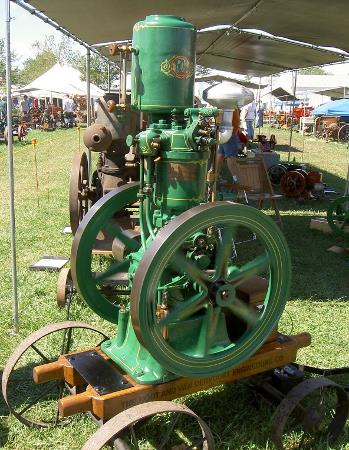
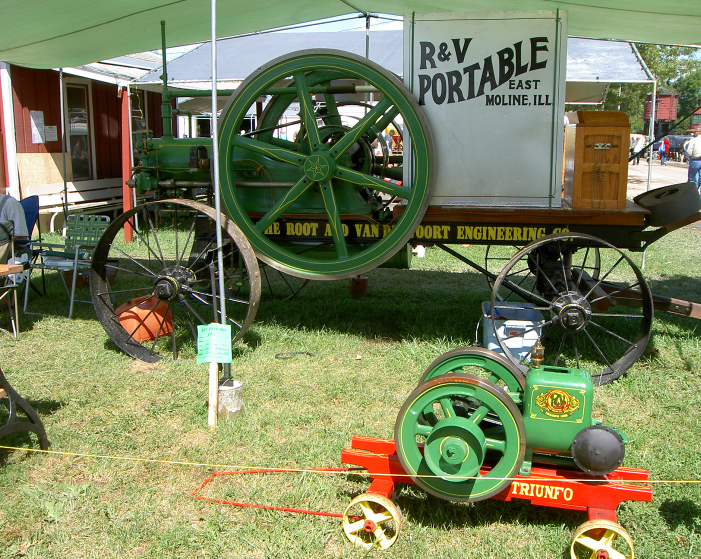
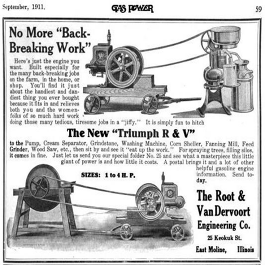
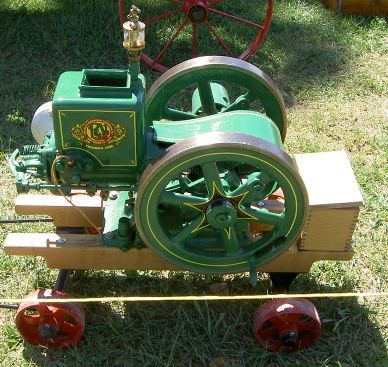
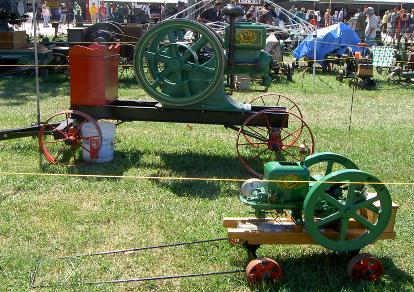
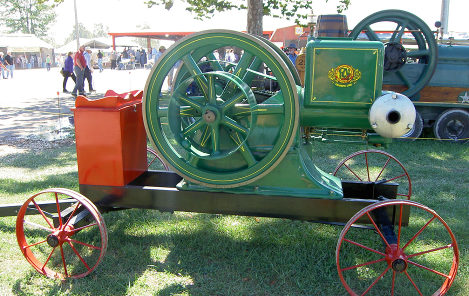
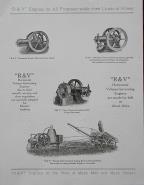
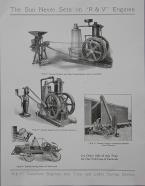
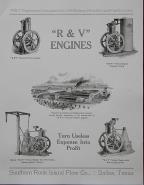
1909-1911 Root & Van Dervoort Engines Below is a b&w copy of the brochure sent out by Southern Rock Island Plow Co. |
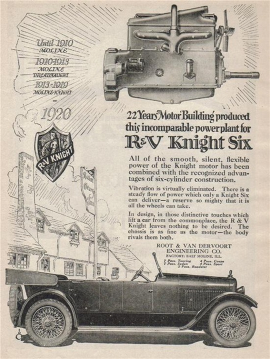
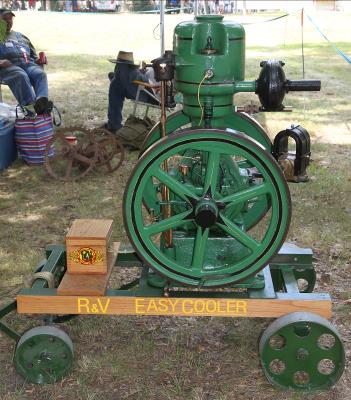
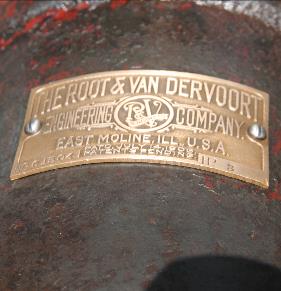
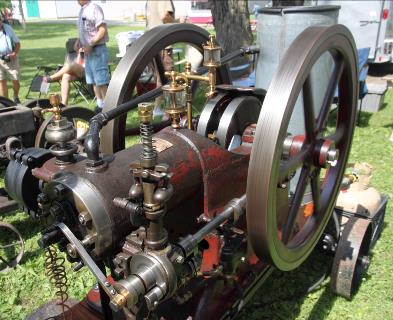
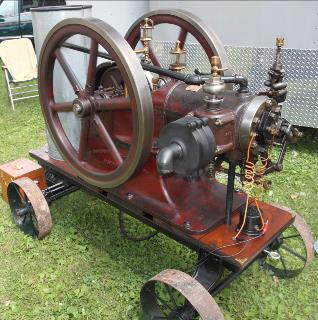
Below: very early R&V prior to the switch to green paint. |
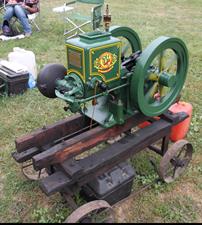
Below Left: R&V Triumph series engines Below Right:R&V Vertical and Easy Cooler |